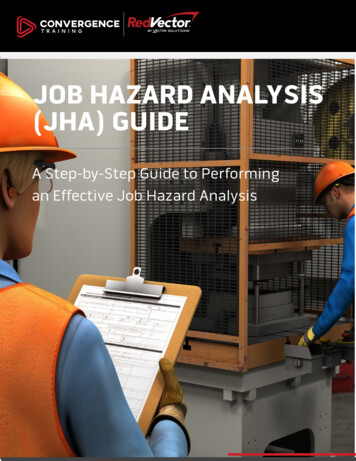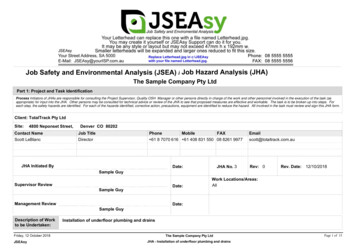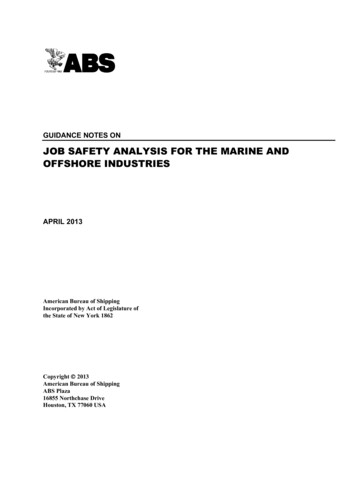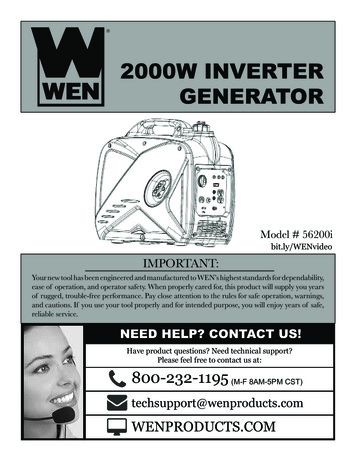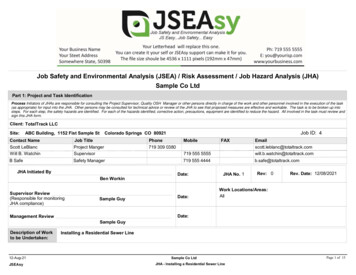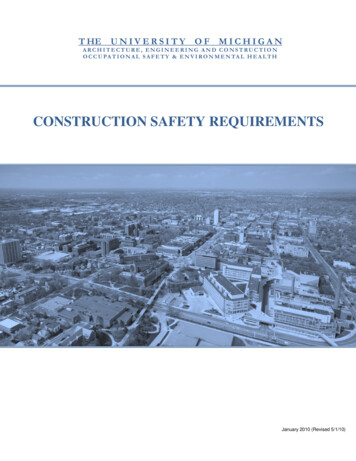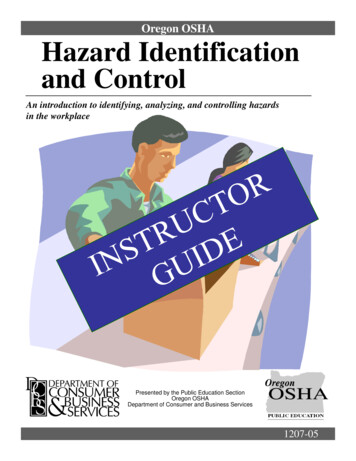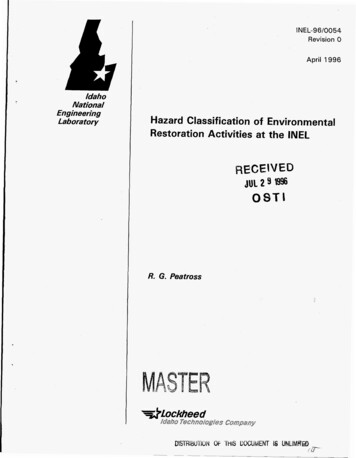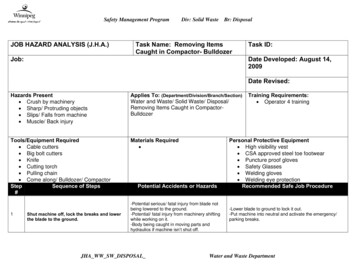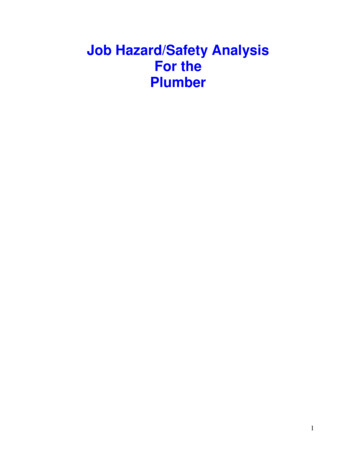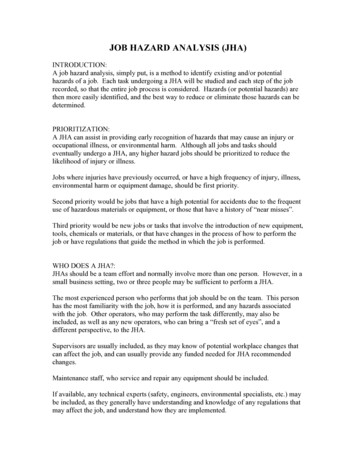
Transcription
JOB HAZARD ANALYSIS (JHA)INTRODUCTION:A job hazard analysis, simply put, is a method to identify existing and/or potentialhazards of a job. Each task undergoing a JHA will be studied and each step of the jobrecorded, so that the entire job process is considered. Hazards (or potential hazards) arethen more easily identified, and the best way to reduce or eliminate those hazards can bedetermined.PRIORITIZATION:A JHA can assist in providing early recognition of hazards that may cause an injury oroccupational illness, or environmental harm. Although all jobs and tasks shouldeventually undergo a JHA, any higher hazard jobs should be prioritized to reduce thelikelihood of injury or illness.Jobs where injuries have previously occurred, or have a high frequency of injury, illness,environmental harm or equipment damage, should be first priority.Second priority would be jobs that have a high potential for accidents due to the frequentuse of hazardous materials or equipment, or those that have a history of “near misses”.Third priority would be new jobs or tasks that involve the introduction of new equipment,tools, chemicals or materials, or that have changes in the process of how to perform thejob or have regulations that guide the method in which the job is performed.WHO DOES A JHA?:JHAs should be a team effort and normally involve more than one person. However, in asmall business setting, two or three people may be sufficient to perform a JHA.The most experienced person who performs that job should be on the team. This personhas the most familiarity with the job, how it is performed, and any hazards associatedwith the job. Other operators, who may perform the task differently, may also beincluded, as well as any new operators, who can bring a “fresh set of eyes”, and adifferent perspective, to the JHA.Supervisors are usually included, as they may know of potential workplace changes thatcan affect the job, and can usually provide any funded needed for JHA recommendedchanges.Maintenance staff, who service and repair any equipment should be included.If available, any technical experts (safety, engineers, environmental specialists, etc.) maybe included, as they generally have understanding and knowledge of any regulations thatmay affect the job, and understand how they are implemented.
WHERE TO PERFORM A JHA:At the workplace, where the job is performed is the best place to perform a JHA. Bydoing the JHA on-site, no steps will be overlooked, and the workplace conditions(lighting, noise, layout, etc.) can be assessed. Recommendations for changes may bemore readily implemented, as well. If possible, the team should watch the job beingperformed so they can understand the sequence of steps and the significance of each step(what is done, in what order, and why).JHAs can be more limited in scope, as well, and jobs can be reviewed verbally. This isusually done only when the job cannot be performed first, it is not a “routine” job, if it isone part of a larger job sequence, or the workplace conditions are not conducive toobserving the job (i.e. dark area, or small workspace).JHAs can also be performed using video surveillance. By using video, there can be bettervisibility for team members and the task can be viewed many times, slowed down, oreven paused for analyzing hazards. However, employees are frequently uncomfortablebeing videotaped and the video tape is only from one angle, so some hazards may beoverlooked.CONDUCTING THE JHA:List the Basic Job StepsNearly every job can be broken down into steps. Each step should be observed by theJHA team. The steps should be discussed, so that everyone understands them, and thereasons the steps are included. The steps should be listed in order of performance. (TheJHA form at the end of this module can be used for this, or another form of yourchoosing.) Action words should be used to describe the steps and they should benumbered sequentially.Below is an example of making coffee using a drip brew machine. Each of the steps isrecorded. There are typically between 3 and 12 steps in a JHA. If there are fewer, thenthe scope of the JHA is too broad and some hazards may be overlooked. If there aremore than 12 steps then the JHA is too detailed, and the JHA team may get “boggeddown” with more detail than they need. For example, in the example below, step 1 couldbe further broken down into 1) walk to the sink 2) Place carafe under faucet, 3) Turn coldwater tap on ¼ turn . That is too detailed and can be simply stated with “Fill carafe withwater to the 10 cup line.Basic Job Steps:1. Fill carafe with water to the 10 cup line2. Pour water into coffee maker reservoir3. Place carafe under drip spout4. Place a single filter in drip basket5. Measure 10 tablespoons of coffee and place into filter6. Place filter basket into coffee maker slot7. Turn coffee maker ON
Determine the Potential Hazards:Hazards are then determined by asking questions such as:1. Can the operator receive a strain or sprain due to bending, twisting, liftingwhile performing any of the steps?2. Can the operator receive a crushing injury to do be caught in, on or betweenequipment?3. Can they receive a burn or irritation due to contact with chemicals, heat, orother physical or biological hazards?4. Could a chemical or material release occur?List The Existing and Potential Hazards:In column 2 of the form, the existing a potential hazards of each step are listed.Each step was previously numbered and any identified hazards or potentialhazards take a letter that corresponds to the process step. All hazards should belisted, even when they are repetitive from previous steps. All steps should beaccounted for, even if there are no hazards associated with them (in such cases,“No Hazard Identified” can be listed).Existing and Potential Hazards1a) Laceration from sharp edge if dropped/broken2a) Laceration from sharp edge if dropped/broken2b) Slip from water spilled on floor3a) Laceration from sharp edge if dropped/broken3b) Burn/scald from coffee if brewing is started prematurely4a) No hazards identified5a) Laceration from coffee can (if can is used)6a) Burn/scald from coffee if brewing is started prematurely7a) Potential shock if coffee maker is faultyMake Recommendations to Reduce/Eliminate or Control HazardsWhere possible, eliminate the hazard, or substitute a non-hazardous material orcondition that will achieve quality results. Where hazards can not be eliminated,provide engineering controls (barriers, interlocks, tools, etc.) that can reduce oreliminate hazardous conditions. Administrative control (procedures, training,limit the exposure time, etc) should be applied to the task where elimination andengineering are not feasible. When all the previous controls can not providehazard reduction, personal protective equipment (PPE) should be considered (i.e.,gloves, respirators, specialized clothing, etc.). PPE should be the last controlconsidered. Remember that PPE frequently requires specialized training,cleaning, or maintenance, and records may need to be kept.Make recommendations for every hazard identified, beginning with the firsthazard listed. You can make several recommendations for one hazard, bearing inmind that one or more may not be feasible, cost effective or timely. Number eachrecommendation in accordance with its hazard (i.e. 1a1, 1a2, 1a3, 2a1, 2a2, etc.).
Recommendations should be specific (what type of gloves, what specific materialwill be substituted, etc.). Existing controls may already control or eliminate somehazards, be sure to list these, so they do not get changed and make the hazardoussituation worse. Where needed, consider that some regulations require specifictypes of controls to be put in place, and if they are prescribed they may not be themost feasible or economical to implement.Recommended Corrective Measures:1a1) Use piped in water delivery system1a2) Use unbreakable or break resistant carafe1a3) Use non-slip, cut proof gloves2a1) Use piped in water delivery system2a2) Use unbreakable or break resistant carafe2a3) Use non-slip, cut proof gloves2b1) Use piped in water delivery system2b2) Place non-skid mats on the floor2b3) Relocate coffee pot to area next to sink3a1) Use piped in water delivery system3a2) Use unbreakable or break resistant carafe3a3) Use non-slip, cut proof gloves .3b1) Written procedure to assure coffee pot is unplugged or in OFFposition3b2) Interlock coffee pot so that brewing can not start without carafe inplace4a1) No corrective action5a1) Use pre-ground coffee from bags rather than cans5a2) Wear protective gloves when scooping coffee from can5a3) Transpose canned coffee into sealable plastic container6a1) Written procedure to assure coffee pot is unplugged or in OFFposition6a2) Interlock coffee pot so that brewing can not start without carafe inplace6b1) Have coffee pot inspected frequently for faulty wiringThe following is the completed JHA form for the “Making Coffee with a Drip Brew Maker”task.
JOB HAZARD ANALYSIS FORMJob or Task being evaluated: Making Coffee with a Drip Brew MakerDate of evaluation: 06/14/2004Page # 1 of 1JHA Team participants: Joe Cuppa, I.M. DeBossStepsPotential or Existing Hazards1) Fill carafe with water to the 10cup line1a) Laceration from sharp edge ifdropped/broken2) Pour water into coffee makerreservoir2a) Laceration from sharp edge ifdropped/broken2b) Slip from water spilled onfloor3) Place carafe under drip spout3a) Laceration from sharp edge ifdropped/broken3b) Burn/scald from coffee ifbrewing is started prematurelyCorrective ActionRecommendations1a1) Use piped in water deliverysystem1a2) Use unbreakable or breakresistant carafe1a3) Use non-slip, cut proofgloves2a1) Use piped in water deliverysystem2a2) Use unbreakable or breakresistant carafe2a3) Use non-slip, cut proofgloves2b1) Use piped in water deliverysystem2b2) Place non-skid mats on thefloor2b3) Relocate coffee pot to areanext to sink3a1) Use piped in water deliverysystem3a2) Use unbreakable or breakresistant carafe3a3) Use non-slip, cut proofgloves .3b1) Written procedure to assurecoffee pot is unplugged or in OFFposition3b2) Interlock coffee pot so thatbrewing can not start withoutcarafe in place4) Place a single filter in dripbasket5) Measure 10 tablespoons ofcoffee and place into filter4a) No hazards identified4a1) No corrective action5a) Laceration from coffee can (ifcan is used)6) Place filter basket into coffeemaker slot6a) Burn/scald from coffee ifbrewing is started prematurely7) Turn coffee maker ON7a) Potential shock if coffeemaker is faulty5a1) Use pre-ground coffee frombags rather than cans5a2) Wear protective gloveswhen scooping coffee from can5a3) Transpose canned coffeeinto sealable plastic container6a1) Written procedure to assurecoffee pot is unplugged or in OFFposition6a2) Interlock coffee pot so thatbrewing can not start withoutcarafe in place7a1) Have coffee pot inspectedfrequently for faulty wiring
EXAMPLE 2 - Swing GrinderThe following picture details a swing grinding operation.Based on what is shown in the picture, follow the steps to complete a JHA.The first step is to list the tasks involved in the swing grinding operation.1. Remove any potential fire hazards and combustibles from the area2. Inspect the grinder to assure it is in good operating condition3. Assure all castings and materials to be ground are accessible, but out of way ofany direct hazards4. Double check the grinding wheel to assure is it the proper size and strength toperform the operation5. Put on Personal Protective Equipment6. Turn grinder on7. Grind castingsThe second step of the JHA is to ask the questions about existing or potential hazards.Noise, Fire, body strain, burns, vibration, dust, fumes, light, flying particles are just a fewhazards that are apparent from the picture. Each of these hazards is associated with one
or more of the steps involved in the swing grinding operation. They should be listed andnumbered accordingly:1a) Body strain from lifting/twisting1b) Potential fire if materials are not moved2a) Operator getting caught in a pinch point2b) Body strain from lifting grinder2c) Dust or particles in eye from previous activity or unkempt workplace2d) Potential for breaking grinding wheel if inspection is not performed orperformed improperly3a) Wasted energy to start and stop grinder if materials are not accessible3b) Potential fire or tripping hazard if materials are in the way.4a) Potential to break grinding wheel if improper size or type for operation5a) Hearing loss from excessive noise5b) Burns from grinding dust and sparks5c) Body strain from lifting, movement while grinding and/or vibration5d) Dust or particles in eye6a) Potential for breaking grinding wheel if inspection is not performed orperformed improperly7a) Body strain from lifting/twisting7b) Potential fire if materials are not moved7c) Operator getting caught in a pinch point, or laceration from contact withgrinding surface7d) Dust or particles in eye from previous activity or unkempt workplace7e) Potential for breaking grinding wheel if inspection is not performed orperformed improperly7f) Wasted energy to start and stop grinder if materials are not accessible7g) Potential fire or tripping hazard if materials are in the way.7h) Hearing loss from excessive noise7i) Burns from grinding dust and sparks7j) Body strain from lifting, movement while grinding and/or vibration7k) Dust or particles in eyeThe next step is to make the recommendations to reduce or eliminate the existing orpotential hazards:1a1) Assure operator is trained in how to lift/twist without injury1a2) Assure operator has the strength/capability of operating the grinder1b1) Have a checklist or other system to assure materials are moved to theircorrect distance or location. The operator must check off the items on the listprior to beginning the operation.1b2) Assure that materials to be ground are in non-combustible containers2a1) Assure that pinch points are properly guarded2a2) Assure that operator is aware of where pinch points are2b1) Assure operator is trained in how to lift/twist without injury2b2) Assure operator has the strength/capability of operating the grinder2c1) Assure proper eye protection (full face shield or welding mask)
2c2) Assure housekeeping is performed after each grinding operation, as neededbetween grinding operations and as needed during grinding operations to reduceor eliminate dust from area2d1) Assure operator or other appropriate individual performs appropriateinspection(s) prior to each grinding operation or weekly, whichever is morefrequent. (The inspection can be part of the checklist in 1b1.)3a1) Have a checklist or other system to assure materials are moved to theircorrect distance or location. The operator must check off the items on the listprior to beginning the operation.3b1) Have a checklist or other system to assure materials are moved to theircorrect distance or location. The operator must check off the items on the listprior to beginning the operation.3b2) Assure appropriate fire protection systems are in place and operational4a1) Assure operator or other appropriate individual performs appropriateinspection(s) prior to each grinding operation or weekly, whichever is morefrequent. (The inspection can be part of the checklist in 1b1.)4a2) Assure proper eye protection (full face shield or welding mask)5a1) Assure proper hearing protection is used by operator and any other exposedpeople5a2) Assure noise levels require hearing protection5a3) Assure grinder is operating at appropriate velocity and parts are properlysecured to reduce vibration, noise and potential for breakage5b1) Assure proper clothing (long pants, long sleeve shirts, leggings and/orprotective sleeves, and gloves) are worn during operation5c1) Assure operator is trained in how to lift/twist without injury5c2) Assure operator has the strength/capability of operating the grinder5c3) Assure grinder is operating at appropriate velocity and parts are properlysecured to reduce vibration.5d1) Assure proper eye protection (full face shield or welding mask)5d2) Assure housekeeping is performed after each grinding operation, as neededbetween grinding operations and as needed during grinding operations to reduceor eliminate dust from area.6a1) Assure operator or other appropriate individual performs appropriateinspection(s) prior to each grinding operation or weekly, whichever is morefrequent. (The inspection can be part of the checklist in 1b1.)6a2) Assure grinder is operating at appropriate velocity and parts are properlysecured to reduce vibration.7a1) Assure operator is trained in how to lift/twist without injury7a2) Assure operator has the strength/capability of operating the grinder7b1) Have a checklist or other system to assure materials are moved to theircorrect distance or location. The operator must check off the items on the listprior to beginning the operation.7b2) Assure appropriate fire protection systems are in place and operational.7b3) Assure housekeeping is performed after each grinding operation, as neededbetween grinding operations and as needed during grinding operations to reduceor eliminate dust from area.
7c1) Assure that pinch points are properly guarded.7c2) Assure that operator is aware of where pinch points are.7c3) Assure that proper protective clothing (long pants, long sleeve shirts,leggings and/or protective sleeves, and gloves) are worn during operation.7d1) Assure proper eye protection (full face shield or welding mask)7d2) Assure housekeeping is performed after each grinding operation, as neededbetween grinding operations and as needed during grinding operations to reduceor eliminate dust from area.7e1) Assure operator or other appropriate individual performs appropriateinspection(s) prior to each grinding operation or weekly, whichever is morefrequent. (The inspection can be part of the checklist in 1b1.)7e2) Assure grinder is operating at appropriate velocity and parts are properlysecured to reduce vibration, noise and potential for breakage.7e3) Assure grinding wheel is properly guarded.7e4) Assure materials are properly secured during grinding.7f1) Have a checklist or other system to assure materials are moved to theircorrect distance or location. The operator must check off the items on the listprior to beginning the operation.7g1) Have a checklist or other system to assure materials are moved to theircorrect distance or location. The operator must check off the items on the listprior to beginning the operation.7h1) Assure proper hearing protection is used by operator and any other exposedpeople.7h2) Assure noise levels require hearing protection7h3) Assure grinder is operating at appropriate velocity and parts are properlysecured to reduce vibration, noise and potential for breakage.7i1) Assure that proper protective clothing (long pants, long sleeve shirts,leggings and/or protective sleeves, and gloves) are worn during operation.7i2) Assure proper eye protection (full face shield or welding mask)7i3) Assure housekeeping is performed after each grinding operation, as neededbetween grinding operations and as needed during grinding operations to reduceor eliminate dust from area.7i4) Assure proper eye protection (full face shield or welding mask)7j1) Assure grinder is operating at appropriate velocity and parts are properlysecured to reduce vibration, noise and potential for breakage.7j2) Assure operator is trained in how to lift/twist without injury7j3) Assure operator has the strength/capability of operating the grinder7k1) Assure proper eye protection (full face shield or welding mask)7k2) Assure housekeeping is performed after each grinding operation, as neededbetween grinding operations and as needed during grinding operations to reduceor eliminate dust from area.All this information should be placed on the JHA form in the appropriate space. The endresult will look like this:
JOB HAZARD ANALYSIS FORMJob or Task being evaluated: Swing Grinding OperationDate of evaluation: July, 2004Page # 1 of 4JHA Team participants: Jim Grinder, I.M. DeBossSteps1. Remove anypotential fire hazardsand combustiblesfrom the areaPotential or ExistingHazards1a) Body strain fromlifting/twisting1b) Potential fire if materialsare not moved2. Inspect thegrinder to assure it isin good operatingcondition2a) Operator getting caught ina pinch point2b) Body strain from liftinggrinder2c) Dust or particles in eyefrom previous activity orunkempt workplace2d) Potential for breakinggrinding wheel if inspection isnot performed or performedimproperly3. Assure allcastings andmaterials to beground areaccessible, but out ofway of any directhazards3a) Wasted energy to start andstop grinder if materials arenot accessible3b) Potential fire or trippinghazard if materials are in theway.Corrective Action Recommendations1a1) Assure operator is trained in how to lift/twistwithout injury1a2) Assure operator has the strength/capability ofoperating the grinder1b1) Have a checklist or other system to assurematerials are moved to their correct distance orlocation. The operator must check off the items onthe list prior to beginning the operation.1b2) Assure that materials to be ground are in noncombustible containers2a1) Assure that pinch points are properly guarded.2a2) Assure that operator is aware of where pinchpoints are.2b1) Assure operator is trained in how to lift/twistwithout injury2b2) Assure operator has the strength/capability ofoperating the grinder2c1) Assure proper eye protection (full face shield orwelding mask)2c2) Assure housekeeping is performed after eachgrinding operation, as needed between grindingoperations and as needed during grinding operationsto reduce or eliminate dust from area.2d1) Assure operator or other appropriate individualperforms appropriate inspection(s) prior to eachgrinding operation or weekly, whichever is morefrequent. (The inspection can be part of the checklistin 1b1.)3a1) Have a checklist or other system to assurematerials are moved to their correct distance orlocation. The operator must check off the items onthe list prior to beginning the operation.3b1) Have a checklist or other system to assurematerials are moved to their correct distance orlocation. The operator must check off the items onthe list prior to beginning the operation.3b2) Assure appropriate fire protection systems arein place and operational.
4. Double check thegrinding wheel toassure is it theproper size andstrength to performthe operation4a) Potential to break grindingwheel if improper size or typefor operation5. Put on PersonalProtectiveEquipment5a) Hearing loss fromexcessive noise5b) Burns from grinding dustand sparks5c) Body strain from lifting,movement while grindingand/or vibration5d) Dust or particles in eye6. Turn grinder on6a) Potential for breakinggrinding wheel if inspection isnot performed or performedimproperly7. Grind castings7a) Body strain fromlifting/twisting7b) Potential fire if materialsare not moved4a1) Assure operator or other appropriate individualperforms appropriate inspection(s) prior to eachgrinding operation or weekly, whichever is morefrequent. (The inspection can be part of the checklistin 1b1.)4a2) Assure proper eye protection (full face shield orwelding mask)5a1) Assure proper hearing protection is used byoperator and any other exposed people.5a2) Assure noise levels require hearing protection5a3) Assure grinder is operating at appropriatevelocity and parts are properly secured to reducevibration, noise and potential for breakage.5b1) Assure proper clothing (long pants, long sleeveshirts, leggings and/or protective sleeves, and gloves)are worn during operation.5c1) Assure operator is trained in how to lift/twistwithout injury5c2) Assure operator has the strength/capability ofoperating the grinder5c3) Assure grinder is operating at appropriatevelocity and parts are properly secured to reducevibration.5d1) Assure proper eye protection (full face shield orwelding mask)5d2) Assure housekeeping is performed after eachgrinding operation, as needed between grindingoperations and as needed during grinding operationsto reduce or eliminate dust from area.6a1) Assure operator or other appropriate individualperforms appropriate inspection(s) prior to eachgrinding operation or weekly, whichever is morefrequent. (The inspection can be part of the checklistin 1b1.)6a2) Assure grinder is operating at appropriatevelocity and parts are properly secured to reducevibration.7a1) Assure operator is trained in how to lift/twistwithout injury7a2) Assure operator has the strength/capability ofoperating the grinder7b1) Have a checklist or other system to assurematerials are moved to their correct distance orlocation. The operator must check off the items onthe list prior to beginning the operation.7b2) Assure appropriate fire protection systems arein place and operational.7b3) Assure housekeeping is performed after eachgrinding operation, as needed between grindingoperations and as needed during grinding operationsto reduce or eliminate dust from area.
( 7. Grind Castings,Continued)7c) Operator getting caught ina pinch point, or lacerationfrom contact with grindingsurface7d) Dust or particles in eyefrom previous activity orunkempt workplace7e) Potential for breakinggrinding wheel if inspection isnot performed or performedimproperly7f) Wasted energy to start andstop grinder if materials arenot accessible7g) Potential fire or trippinghazard if materials are in theway.7h) Hearing loss fromexcessive noise7i) Burns from grinding dustand sparks7c1) Assure that pinch points are properly guarded.7c2) Assure that operator is aware of where pinchpoints are.7c3) Assure that proper protective clothing (longpants, long sleeve shirts, leggings and/or protectivesleeves, and gloves) are worn during operation.7d1) Assure proper eye protection (full face shield orwelding mask)7d2) Assure housekeeping is performed after eachgrinding operation, as needed between grindingoperations and as needed during grinding operationsto reduce or eliminate dust from area.7e1) Assure operator or other appropriate individualperforms appropriate inspection(s) prior to eachgrinding operation or weekly, whichever is morefrequent. (The inspection can be part of the checklistin 1b1.)7e2) Assure grinder is operating at appropriatevelocity and parts are properly secured to reducevibration, noise and potential for breakage.7e3) Assure grinding wheel is properly guarded.7e4) Assure materials are properly secured duringgrinding.7f1) Have a checklist or other system to assurematerials are moved to their correct distance orlocation. The operator must check off the items onthe list prior to beginning the operation.7g1) Have a checklist or other system to assurematerials are moved to their correct distance orlocation. The operator must check off the items onthe list prior to beginning the operation.7h1) Assure proper hearing protection is used byoperator and any other exposed people.7h2) Assure noise levels require hearing protection7h3) Assure grinder is operating at appropriatevelocity and parts are properly secured to reducevibration, noise and potential for breakage.7i1) Assure that proper protective clothing (longpants, long sleeve shirts, leggings and/or protectivesleeves, and gloves) are worn during operation.7i2) Assure proper eye protection (full face shield orwelding mask)7i3) Assure housekeeping is performed after eachgrinding operation, as needed between grindingoperations and as needed during grinding operationsto reduce or eliminate dust from area.7i4) Assure proper eye protection (full face shield orwelding mask)
(7. Grind Castings,continued)7j) Body strain from lifting,movement while grindingand/or vibration7k) Dust or particles in eye7j1) Assure grinder is operating at appropriatevelocity and parts are properly secured to reducevibration, noise and potential for breakage.7j2) Assure operator is trained in how to lift/twistwithout injury7j3) Assure operator has the strength/capability ofoperating the grinder7k1) Assure proper eye protection (full face shield orwelding mask)7k2) Assure housekeeping is performed after eachgrinding operation, as needed between grindingoperations and as needed during grinding operationsto reduce or eliminate dust from area.
JHA COMPLETIONSupervisors or managers, and/or the JHA team are responsible for:1. Verifying the JHA steps and the viability of recommendations2. Selecting those corrective actions that will be implemented3. Tracking corrective actions to assure they are completed4. Ensuring corrective actions provide the appropriate level of safety and that theydo not create additional hazards5. Determining if procedures, checklists, training, etc require updating based on therecommended corrective actions.SUMMARYJHAs can be useful tools, especially when hazards may not be easily identifiable. Byperforming JHAs, a company can improve its safety performance, potentially reduceoperating costs and keep employees involved in the safety process.
JOB HAZARD ANALYSIS FORMJob or Task being evaluated:Date of evaluation:Page # ofJHA Team participants:StepsPotential or ExistingHazardsCorrective ActionRecommendations
JOB HAZARD ANALYSIS (JHA) INTRODUCTION: A job hazard analysis, simply put, is a method to identify existing and/or potential hazards of a job. Each task undergoing a JHA will be studied and each step of the job recorded, so that the entire job
